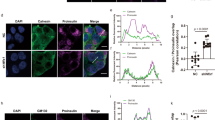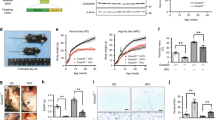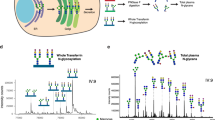Abstract
Dietary fat is an important source of nutrition. Here we identify eight mutations in SARA2 that are associated with three severe disorders of fat malabsorption. The Sar1 family of proteins initiates the intracellular transport of proteins in COPII (coat protein)-coated vesicles. Our data suggest that chylomicrons, which vastly exceed the size of typical COPII vesicles, are selectively recruited by the COPII machinery for transport through the secretory pathways of the cell.
This is a preview of subscription content, access via your institution
Access options
Subscribe to this journal
Receive 12 print issues and online access
$209.00 per year
only $17.42 per issue
Buy this article
- Purchase on Springer Link
- Instant access to full article PDF
Prices may be subject to local taxes which are calculated during checkout

Similar content being viewed by others
References
Roy, C.C. et al. Gastroenterology 92, 390–399 (1987).
Nemeth, A. et al. Eur. J. Clin. Invest. 25, 271–280 (1995).
Bouma, M.E., Beucler, I., Aggerbeck, L.P., Infante, R. & Schmitz, J. J. Clin. Invest. 78, 398–410 (1986).
Dannoura, A.H. et al. Arterioscler. Thromb. Vasc. Biol. 19, 2494–2508 (1999).
Aguglia, U. et al. Ann. Neurol. 47, 260–264 (2000).
Takai, Y., Sasaki, T. & Matozaki, T. Physiol. Rev. 81, 153–208 (2001).
Schekman, R. & Orci, L. Science 271, 1526–1533 (1996).
Huang, M. et al. J. Cell Biol. 155, 937–948 (2001).
Saito, Y., Kimura, K., Oka, T. & Nakano, A. J. Biochem. (Tokyo) 124, 816–823 (1998).
Kuge, O. et al. J. Cell Biol. 125, 51–65 (1994).
Bi, X., Corpina, R.A. & Goldberg, J. Nature 419, 271–277 (2002).
Antonny, B., Madden, D., Hamamoto, S., Orci, L. & Schekman, R. Nat. Cell Biol. 3, 531–537 (2001).
Powell, L.M. et al. Cell 50, 831–840 (1987).
Kuehn, M.J., Herrmann, J.M. & Schekman, R. Nature 391, 187–190 (1998).
Aridor, M. et al. J. Cell Biol. 152, 213–229 (2001).
Acknowledgements
We thank G. Mcphail and J. Amey for their contributions to the study, T. Aitman and A. Soutar for critical reading of the manuscript and R. Lale-Montes for excellent secretarial assistance. We are indebted to the British Heart Foundation and Medical Research Council, Swedish Research Council and Heart-Lung Foundation. Approved gene symbols were obtained from the HUGO Gene Nomenclature Committee.
Author information
Authors and Affiliations
Corresponding authors
Ethics declarations
Competing interests
The authors declare no competing financial interests.
Rights and permissions
About this article
Cite this article
Jones, B., Jones, E., Bonney, S. et al. Mutations in a Sar1 GTPase of COPII vesicles are associated with lipid absorption disorders. Nat Genet 34, 29–31 (2003). https://doi.org/10.1038/ng1145
Received:
Accepted:
Published:
Issue Date:
DOI: https://doi.org/10.1038/ng1145
This article is cited by
-
Manganese regulation of COPII condensation controls circulating lipid homeostasis
Nature Cell Biology (2023)
-
Manganese controls lipoprotein secretion via biomolecular condensation
Nature Cell Biology (2023)
-
The genetics of monogenic intestinal epithelial disorders
Human Genetics (2023)
-
Chylomicron retention disease caused by a new pathogenic variant in sar1b protein: a rare case report from Syria
BMC Pediatrics (2021)
-
Grasp55−/− mice display impaired fat absorption and resistance to high-fat diet-induced obesity
Nature Communications (2020)



